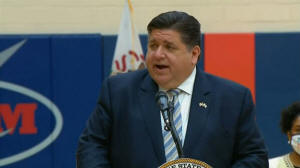State releases guide to school reopening
 Send a link to a friend
Send a link to a friend
[April 01, 2021]
By PETER HANCOCK
Capitol News Illinois
phancock@capitolnewsillinois.com
 SPRINGFIELD — Educators, students and
families will face a host of new challenges in overcoming the learning
loss that occurred over the past year of mostly remote learning as
COVID-19 vaccines become more widely available and schools prepare to
fully reopen for in-person learning. SPRINGFIELD — Educators, students and
families will face a host of new challenges in overcoming the learning
loss that occurred over the past year of mostly remote learning as
COVID-19 vaccines become more widely available and schools prepare to
fully reopen for in-person learning.
To aid in that process, Gov. JB Pritzker announced the release of a new
180-page Learning Renewal Resource Guide to help school officials
identify and address the most significant challenges they face.
Pritzker said Illinois school districts can expect to receive roughly $7
billion in federal funds to help them transition back to in-person
learning, mainly through the recently-passed American Rescue Plan. About
90 percent of that money will come in the form of direct payments.

In addition, higher education institutions in Illinois will receive
about $1.3 billion from the third round of federal relief that was
approved in December, for a total of $2.5 billion across all three
rounds of federal funding, mainly from the Higher Education Emergency
Relief Fund.
“With these enormous new resources comes the great challenge that most
districts have never had to face – how to avoid having the last 12
months become the lost year for our students,” Pritzker said at a news
conference at South Elgin High School in the western Chicago suburbs,
the state’s second-largest school district. “To revitalize learning for
teachers and students and educators, our response must be intensive,
holistic and practical.”
The resource guide is the work of the Illinois P-20 Council, an agency
established in 2009 to study and make recommendations for all levels of
education, from preschool through post-college education. The guide was
developed in collaboration with the Illinois State Board of Education,
the Illinois Board of Higher Education, the Illinois Community College
Board, the Illinois Student Assistance Commission and the Governor’s
Office of Early Childhood Development, with support from A Better
Chicago and Advance Illinois.
Just as the pandemic exacerbated inequities that already existed within
the nation’s health care system, State Superintendent of Education
Carmen Ayala said it also had a disproportionate impact on low-income
students, who often have limited or no access to home computers or
broadband internet service, as well as students of color.
[to top of second column]
|

Gov. JB Pritzker speaks at South Elgin High School to announce the
release of a new resource guide schools can use as they prepare for
a return to in-person learning. (Credit: Blueroomstream.com)

But she also said that as schools reopen post-pandemic, they will
have a new set of resources to help address those underlying
inequities.
“With the influx of federal funding and the learning renewal
resource guide, we are now presented with a unique opportunity to
transform systems of learning for students, to reshape our new
normal, so that our students return to an education system that is
more equitable, more individualized and more responsive to their
needs,” she said.
Melissa Figueira, senior policy associate with Advance Illinois,
said it has also had a dramatic impact on enrollment at all levels
of education – an estimated 1.9 percent drop in pre-K through 12
schools, with the biggest declines in kindergarten through third
grade, and a 5 percent decline in post-secondary enrollment.
The resource guide details 12 topics that districts and higher
education institutions may want to consider to equitably address the
pandemic’s short-term and long-term impacts.
Among them are ways to support enrollment and retention, redesigning
the school calendar by expanding school days and the school year,
ways to provide out of classroom learning experiences through
tutoring, before and after school programs and summer camps, and
enhancing the availability of both academic and behavioral
counseling.
In addition to the resource guide, the governor’s office said in a
statement that state education agencies will focus on four major
goals to support schools: high-impact tutoring; social and emotional
learning community partnerships; interim assessments to measure the
impact the pandemic has had on student learning; and to encourage
enrollment in both early childhood programs and higher education.
Capitol News Illinois is a nonprofit, nonpartisan
news service covering state government and distributed to more than
400 newspapers statewide. It is funded primarily by the Illinois
Press Foundation and the Robert R. McCormick Foundation.
 |